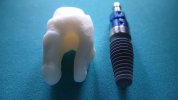T
tuyere
Active Member
Full Member
- Messages
- 391
- Solutions
- 2
- Reaction score
- 0
I recently learned about root analog implants ( https://en.wikipedia.org/wiki/Root_analogue_dental_implant ) and I'm intrigued- it seems like a much more elegant and low-impact way to do implants vs. industry standard techniques. It also seems like a very good fit for modern digital workflows that can actually produce a fully-anatomic design within a few hours or days of a tooth being pulled. It doesn't seem to have been commercially adopted in any capacity, and some of the old hats I asked about this had never even heard of the technique.
So, has anybody encountered any of these cases in the wild? Are they limited to a handful of experimental/trial cases? Does anybody have any resources on this technique where I can learn more? Full disclosure that I'm relatively new to this industry so it's possible I've overlooked something obvious and/or embarrassing.
So, has anybody encountered any of these cases in the wild? Are they limited to a handful of experimental/trial cases? Does anybody have any resources on this technique where I can learn more? Full disclosure that I'm relatively new to this industry so it's possible I've overlooked something obvious and/or embarrassing.



